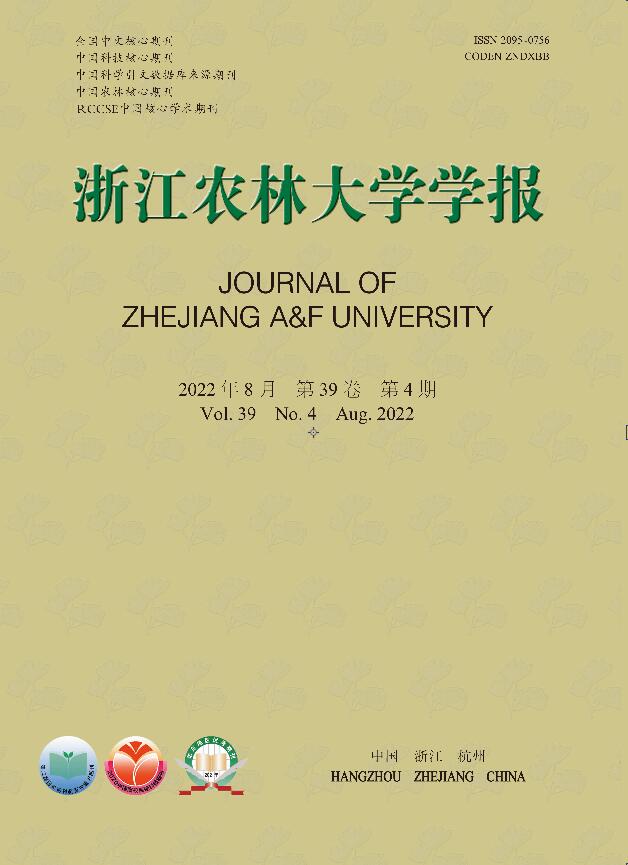-
杨树Populus作为速生用材树种,具有广泛的用途,尤其是在制浆造纸、人造纤维和纤维板制造业中占有重要地位。木材纤维是杨树木材的主要组成部分,也是制浆及纤维制造业的主要原料,纤维性状的优劣直接决定着杨树纤维材的开发利用与发展[1]。然而,纤维形态特征及纤维含量对不同品种或无性系而言均存在着差异,即使同一树种的不同个体或同株不同部位亦有明显差异[2]。Jr FARMER等[3]利用美洲黑杨Populus deltoids无性系幼林作为试验材料,开展了木材纤维长度性状变异研究,证明了纤维性状在无性系间也呈较大差异。王明庥等[4]对杂种无性系的材性变异研究表明:纤维相关性状呈株内变异特点,且各性状间的变异具有独立性。查朝生等[5]对杨树无性系人工林的木材纤维形态特征进行了研究,表明纤维长、纤维宽以及纤维长宽比随着生长轮的增加,呈增大趋势。MANSFIELD等[6]对不同产地15个山杨Populus davidiana无性系的木材纤维性状进行研究发现:纤维性状在不同品种及林分间均呈显著变异。刘玉鑫等[7]研究表明:美洲黑杨无性系纤维性状存在遗传变异,且变异受遗传的影响大于受环境的影响。综上可知,杨树无论是品种间、林分间、无性系间或是单株的不同部位都存在变异的可能,因此,分析与评价杨树不同无性系间纤维性状差异性,不仅能够为选育适用于木材工业化生产及大规模加工利用高附加值的杨树优良新品种提供参考,而且对促进杨树人工林及杨树相关产业的可持续发展具有重要意义。鉴于此,本研究选择树干通直圆满,生长量大,且在长江流域及洞庭湖区分布广、适生性较强的7个杨树无性系为材料,对纤维素形态特征及含量差异进行了研究,综合评价了各无性系纤维性状指标,旨在为杨树无性系选择纤维材优良品系提供科学依据。
-
试验林于2009年造林,林分株行距为4 m×6 m。林内共18个杨树无性系,各无性系按完全随机区组试验排列,每个无性系10株,3次重复。试验林造林后3~4 a,每年浅耕1~2次,林下间种南瓜Cucurbita moschato;造林后2~6 a,于每年的4月下旬至5月上旬采用环状沟施肥法施尿素或复合肥(250~500 g·株−1) 1次;造林后第3年、第5年以及第7年,每年12月修枝1次,3次修枝强度(修枝高度与树高比)分别为35%、40%和40%;其他管理措施为常规管理。
选取试验林中树干圆满且通直,生长较快的杨树XL-80、XL-86、XL-83、XL-58、XL-75、ZH-17、I-69(对照)等7个无性系作为材料,每个无性系选取3株标准木测定树高及胸径,伐倒后作为生物量测定和纤维性状取样对象。在伐倒样株胸径处取一个厚5 cm的圆盘作为木材纤维形态测定试样。
-
各无性系样木伐倒后,将地上部分分成干、枝、叶,树干每2 m分为一段,分别称各部位的鲜质量,然后各部位在105 ℃下烘干并称量,最后根据样品干质量和湿质量的比例,换算单株生物量干质量[12]。单株纤维素质量的估算:单株纤维素质量=单株生物量干质量×纤维素质量分数。采集的样品经处理后,纤维素质量分数测定采用硝酸-乙醇法,木材纤维长和纤维宽采用刘超逸等[13]的测定方法。
-
运用Excel、SPSS等软件进行不同无性系间的数据统计和方差分析。各无性系间生长性状及纤维形态及含量综合评价采用加权综合得分法。
-
由表1可以看出:树体性状和木材纤维性状变异幅度较大,为2.66%~21.76%,其中生物量(21.76%)和单株纤维素(21.35%)的变异系数较大,均超过21%,树高和纤维宽的变异系数较小,为2.0%~3.2%,表明杨树各性状间变异的差异较大,可选择利用的空间广阔。
性状 胸径/cm 树高/m 生物量/(kg·株−1) 纤维长/mm 纤维宽/mm 纤维长宽比 纤维素质量分数/% 单株纤维素/(kg·株−1) 平均值 31.28 25.22 301.81 1.04 0.02 52.03 57.78 175.46 标准差 3.08 0.81 65.68 0.05 0.00 1.82 2.31 37.47 变异系数/% 9.84 3.19 21.76 4.99 2.66 3.50 3.99 21.35 Table 1. Character variation of poplar clones
-
从表2可知:7个杨树无性系的纤维长为0.95~1.12 mm,纤维宽为0.019~0.021 mm,纤维长宽比为49.1~54.6。其中,无性系XL-83的纤维长最小,为0.95 mm,与其他无性系纤维长呈极显著差异(P<0.01);除无性系XL-83外,其他无性系的纤维长差异均不显著(P>0.05),且无性系XL-58、XL-86以及XL-80纤维长均达1.05 mm以上。无性系之间纤维宽差异均不显著(P>0.05)。无性系的纤维长宽比从大到小依次为I-69、XL-58、XL-86、XL-75、ZH-17、XL-80、XL-83。各无性系间的纤维长宽比存在一定差异,其中无性系XL-83与I-69、XL-58、XL-86均呈显著差异(P<0.05)。
无性系 纤维长/mm 纤维宽/mm 纤维长宽比 XL-80 1.06±0.05 Ab 0.021±0.001 a 50.93±0.91 ac XL-86 1.07±0.05 Ab 0.021±0.001 a 52.52±2.50 a XL-83 0.95±0.03 Bc 0.019±0.001 a 49.09±9.19 bc XL-58 1.12±0.10 Aa 0.021±0.000 a 53.84±3.81 a XL-75 1.02±0.03 Ab 0.020±0.001 a 51.91±2.00 ac ZH-17 1.04±0.07 Ab 0.020±0.001 a 51.81±1.80 ac I-69 1.08±0.05 Ab 0.020±0.001 a 54.62±4.70 a 说明:数值为平均值±标准差;同列不同大写字母表示同 一指标在不同无性系之间差异极显著(P<0.01);同 列不同小写字母表示同一指标在不同无性系之间差 异显著(P<0.05) Table 2. Fiber characteristics of poplar clones
-
从表3可以看出:无性系生物量间差异显著(P<0.05),生物量为194.27~401.73 kg·株−1,其中生物量最大的无性系为XL-80 (401.73 kg·株−1),最小的无性系为对照I-69 (194.27 kg·株−1)。各无性系间纤维素质量分数存在一定差异,除无性系XL-83与其他无性系的纤维素质量分数呈显著差异(P<0.05)外,其他无性系间纤维素质量分数差异不显著(P>0.05)。无性系纤维素质量分数为53.06%~59.66%,均高出造纸所需纤维素质量分数的基本要求(40%)。无性系单株纤维素为114.04~233.81 kg·株−1,其中最高的无性系为XL-80 (233.81 kg·株−1),对照I-69单株纤维素仍为最小,仅114.04 kg·株−1。无性系单株纤维素呈不同程度的差异,其中无性系XL-80与XL-86单株纤维素呈显著差异(P<0.05),与其他无性系均呈极显著差异(P<0.01);无性系I-69与供试的其他无性系均呈极显著差异(P<0.01),无性系XL-75与ZH-17差异不显著(P>0.05)。
无性系 生物量/
(kg·株−1)纤维素质量
分数/%单株纤维素/
(kg·株−1)XL-80 401.73±12.09 Aa 58.22±0.40 a 233.81±5.43 Aa XL-86 335.98±10.90 Bb 59.66±0.23 a 200.58±7.18 Ab XL-83 329.23±9.34 Cc 53.06±0.41 b 174.82±3.64 Bb XL-58 320.14±1.62 Dd 58.55±0.50 a 187.60±2.55 Bc XL-75 268.67±1.96 Ef 59.17±0.94 a 159.05±3.58 BCe ZH-17 270.31±0.96 Ee 59.66±0.53 a 161.38±0.78 BCe I-69 194.27±3.76 Fg 58.66±0.10 a 114.04±2.01 Df 说明:数值为平均值±标准差;同列不同大写字母表示同 一指标在不同无性系之间差异极显著(P<0.01);同 列不同小写字母表示同一指标在不同无性系之间差 异显著(P<0.05) Table 3. Differences in biomass and wood cellulose content of poplar clones
-
木材纤维性状与生长性状间的相关分析结果(表4)表明:生长性状树高、胸径、生物量以及单株纤维素之间呈极显著正相关(P<0.01)。纤维长与纤维宽、纤维长宽比以及纤维素质量分数呈显著正相关(P<0.05),纤维长宽比与纤维素质量分数呈显著正相关(P<0.05)。木材纤维性状与生长性状之间相关性各异,纤维宽与树高、胸径、生物量呈正相关但不显著(P>0.05),纤维长、纤维长宽比及纤维素质量分数分别与胸径、树高及生物量均呈负相关,且均不显著(P>0.05),表现出独立遗传特性。
项目 胸径 树高 生物量 纤维长 纤维宽 纤维长宽比 纤维素质量分数 单株纤维素 胸径 1 树高 0.926** 1 生物量 0.995** 0.903** 1 纤维长 −0.146 −0.178 −0.111 1 纤维宽 0.520 0.366 0.556 0.734* 1 纤维长宽比 −0.598 −0.534 −0.572 0.863* 0.293 1 纤维素质量分数 −0.258 −0.210 −0.237 0.716* 0.467 0.682* 1 单株纤维素 0.972** 0.887* 0.981** 0.032 0.667* −0.448 −0.043 1 说明:*表示相关显著(P<0.05);**表示相关极显著(P<0.01) Table 4. Correlation between clonal growth traits and wood fiber traits
-
纤维材培育的最终目标是尽可能多地提供优质的纤维。因林木的生长量与木材产量呈正相关,木材的纤维形态又直接关系到林木纤维的产量和质量,因此,纤维材的产量以及纤维形态和含量是评价和选择该材种优劣的重要依据。本研究通过主成分分析(表5)得出:决定第1主成分的主要是生物量、纤维素质量分数和单株纤维素;决定第2主成分的主要是纤维长和纤维宽,前2个主成分已经能够解释原有各性状的大部分信息,故可以选择前2个主成分进行综合评分。根据所选主成分的贡献率对主成分得分进行加权平均,求得主成分综合得分(表6)。由表6可以看出:供试7个无性系综合得分由大到小依次为XL-80、XL-58、XL-86、ZH-17、XL-83、XL-75、I-69,该综合得分排序与各无性系的生物量、纤维长、纤维宽、纤维长宽比及纤维素质量分数排序具有一定的一致性。通过综合评比,入选的前5个杨树无性系综合了各性状的优良水平,也突出了联合选择在纤维材良种选育中的重要性。
性状 主成分 1 2 生物量 0.875 −0.028 纤维长 −0.018 0.435 纤维宽 −0.201 0.365 纤维素质量分数 0.236 0.099 单株纤维素 0.935 0.035 Table 5. Feature vectors of main characters
无性系 第1主成分得分 第2主成分得分 综合得分 排序 XL-80 2.489 2.547 2.510 1 XL-86 0.952 0.982 0.963 3 XL-83 −0.944 −0.907 −0.931 5 XL-58 1.252 1.110 1.202 2 XL-75 −1.204 −1.117 −1.173 6 ZH-17 −0.522 −0.438 −0.493 4 I-69 −2.024 −2.177 −2.078 7 Table 6. Comprehensive evaluation score of each clone
-
木材纤维占阔叶树木材总体积的50%以上,木材纤维的形态指标直接影响着木材的硬度、强度以及制浆造纸性能,与木材物理力学性能以木材的开发利用息息相关[14-15]。曾广植[16]研究得出:纤维长与纸张强度呈线性正相关;张平冬等[17]认为:纤维长宽比越大,越能增加纤维之间交织次数,提升结合能力,从而增强纸张的强固性和割裂性[7];汪殿蓓等[18]研究表明:纤维长宽比大于56是优良的造纸原料。本研究杨树无性系的纤维长以及纤维长宽比最小分别为0.95 mm和49.09,均达到或超出国际木材解剖学中所规定的中级长度纤维(0.91~1.60 mm)以及长宽比不低于35~45的标准[4],其中纤维长与刘玉鑫等[7]、查朝生等[5]的测定结果相当,但纤维长宽比均高于以上测定结果,且主成分综合得分排名中,前5个无性系的纤维长宽比均在58.2以上。进一步表明本研究杨树无性系的纤维性状均较优,其中主成分分析评价得分较高的前5个无性系更适合用于纸浆或纤维用材。
性状间遗传变异差异较大,要开展多性状选择就需要探明各性状间相互关系。而杨树作为速生树种,其生长性状在进行良种选择时是必须考虑的指标,材性性状无论是作为结构材还是纤维用材都是综合评价的关键因子,因此,生长性状、材性性状以及生长性状与材性性状间的相关性是杨树遗传改良的重要依据。黄家华[19]以鹅掌楸Liriodendron chinenese等14个种源作为研究材料,发现生长性状与纤维宽及纤维长宽比均呈负相关;覃敏[20]评价了6年生米老排Mytilaria laosensis子代测定林,发现除纤维宽外,生长性状与木材性状的改良具有相对独立性;黄寿先[21]选取12个杉木Cunninghamia lanceolata无性系对制浆造纸性能的变异及其与生长、材性的相关性进行了研究,得出胸径、树高与管胞长度、宽度、管胞长宽比等呈不显著到显著的遗传负相关;李开隆等[22]通过对山杨材性与生长性状的相关性分析得出:纤维长、纤维宽及纤维长宽比均与树高、胸径等生长性状相关不显著。以上研究表明:纤维性状与生长性状呈一定的相关性,但相关性均不显著,说明纤维性状与生长性状间具有一定的独立性,在进行林木选育时可实现生长与材性同步选择。本研究分析了供试杨树无性系的生长性状与纤维性状间的相关性,发现纤维宽与树高、胸径及生物量呈正相关,但不显著,纤维长、纤维长宽比及纤维素质量分数分别与胸径、树高及生物量呈负相关性,且均不显著。该结论与以上研究结论[19-22]具有一定的相似性。杨树生长性状与纤维性状间存在着负相关或相关性不显著,说明这2个性状在遗传机制中是相互独立的,可开展杨树生长性状与纤维性状的联合改良。
多性状综合评价选择法能够在相关性复杂的多性状之间权衡取舍,使目标性状得到进一步改良,同时又能够保留其他优良性状。本研究利用主成分分析加权综合得分法对杨树无性系进行综合评价,初步筛选出XL-80、XL-58、XL-86、ZH-17、XL-83等5个优良无性系,无性系XL-58的纤维长度最长,高出群体均值7.25%;无性系XL-80的生物量最大,高出群体均值33.11%;无性系XL-86和ZH-17的纤维素含量最高,高出群体均值3.32%;无性系XL-83各性状虽没有最突出的,但各性状在供试无性系评比中排序都是靠前的,也均达到了优良纤维材的整体水平[23-24]。综上所述,评价筛选的5个优良纤维材无性系综合了各性状的优良特性,既考虑到了生长性状又兼顾了纤维性状对林木选优的影响,能够最大程度地实现物尽其用,达到杨树无性系资源利用的最大化,同时也为杨树多目标育种提供了更丰富的遗传资源与选育途径。
-
本研究表明:7个杨树无性系生物量、木材纤维长及单株纤维素差异显著,纤维素质量分数存在一定的差异,各性状变异幅度较大,这些为杨树资源的良种选育及性状改良提供了遗传基础与参考依据;主成分分析表明:生物量、纤维素质量分数和单株纤维素代表了杨树无性系各性状的综合水平,是杨树纤维材评选的主导因子。综合评价选出木材纤维性状综合表现较优的5个无性系(XL-80、XL-58、XL-86、ZH-17、XL-83),这些无性系除生长性状表现优良外,木材纤维各项指标均达到了造纸所需原料的中优水平。
Analysis and evaluation of growth and wood fiber characters of seven poplar clones in southern China
doi: 10.11833/j.issn.2095-0756.20210481
- Received Date: 2021-07-12
- Accepted Date: 2022-03-27
- Rev Recd Date: 2022-03-11
- Available Online: 2022-07-20
- Publish Date: 2022-08-20
-
Key words:
- southern China /
- poplar /
- wood fiber /
- clone /
- comprehensive evaluation
Abstract:
| Citation: | YANG Yan, TANG Jie, LI Yongjin, et al. Analysis and evaluation of growth and wood fiber characters of seven poplar clones in southern China[J]. Journal of Zhejiang A&F University, 2022, 39(4): 807-813. DOI: 10.11833/j.issn.2095-0756.20210481 |









 DownLoad:
DownLoad: